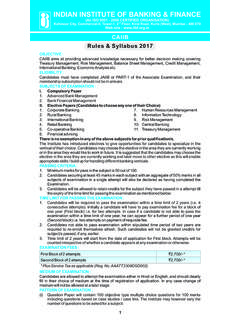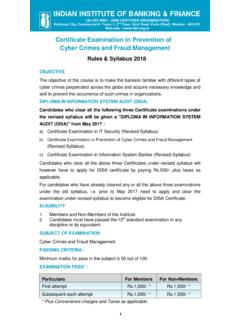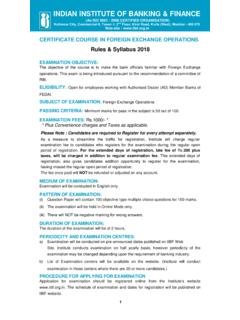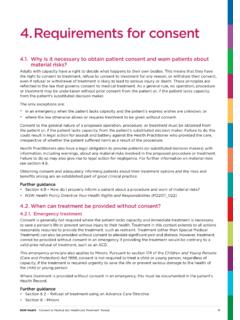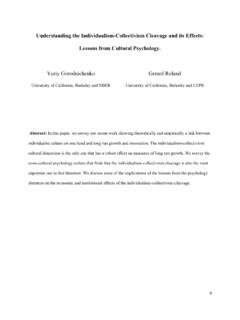Transcription of Chapter 19 Cyber Laws in India
1 1 Chapter 19 Cyber laws in India Objectives: This Chapter presents the meaning and definition of Cyber crime, the legislation in India dealing with offences relating to the use of or concerned with the abuse of computers or other electronic gadgets. The Information Technology Act 2000 and the Amendment Act 2008 have been dealt with in detail and other legislations dealing with electronic offences have been discussed in brief. Introduction: Crime is both a social and economic phenomenon. It is as old as human society.
2 Many ancient books right from pre-historic days, and mythological stories have spoken about crimes committed by individuals be it against another individual like ordinary theft and burglary or against the nation like spying, treason etc. Kautilya s Arthashastra written around 350 BC, considered to be an authentic administrative treatise in India , discusses the various crimes, security initiatives to be taken by the rulers, possible crimes in a state etc. and also advocates punishment for the list of some stipulated offences.
3 Different kinds of punishments have been prescribed for listed offences and the concept of restoration of loss to the victims has also been discussed in it. Crime in any form adversely affects all the members of the society. In developing economies, Cyber crime has increased at rapid strides, due to the rapid diffusion of the Internet and the digitisation of economic activities. Thanks to the huge penetration of technology in almost all walks of society right from corporate governance and state administration, up to the lowest level of petty shop keepers computerizing their billing system, we find computers and other electronic devices pervading the human life.
4 The penetration is so deep that man cannot spend a day without computers or a mobile. Snatching some one s mobile will tantamount to dumping one in solitary confinement! Cyber Crime is not defined in Information Technology Act 2000 nor in the Amendment Act 2008 nor in any other legislation in India . In fact, it cannot be too. Offence or crime has been dealt with elaborately listing various acts and the punishments for each, under the Indian Penal Code, 1860 and quite a few other legislations too.
5 Hence, to define Cyber crime, we can say, it is just a combination of crime and computer. To put it in simple terms any offence or crime in which a computer is used is a Cyber crime . Interestingly even a petty offence like stealing or pick-pocket can be brought within the broader purview of Cyber crime if the basic data or aid to such an offence is a computer or an information stored in a computer used (or misused) by the fraudster. The Act defines a computer, computer network, data, information and all other necessary ingredients that form part of a Cyber crime, about which we will now be discussing in detail.
6 In a Cyber crime, computer or the data itself the target or the object of offence or a tool in committing some other offence, providing the necessary inputs for that offence. All such acts of crime will come under the broader definition of Cyber crime. 2 Let us now discuss in detail, the Information Technology Act -2000 and the Amendment Act 2008 in general and with particular reference to banking and financial sector related transactions. Before going into the section-wise or Chapter -wise description of various provisions of the Act, let us discuss the history behind such a legislation in India , the circumstances under which the Act was passed and the purpose or objectives in passing it.
7 The Genesis of IT legislation in India : Mid 90 s saw an impetus in globalization and computerisation, with more and more nations computerizing their governance, and e-commerce seeing an enormous growth. Until then, most of international trade and transactions were done through documents being transmitted through post and by telex only. Evidences and records, until then, were predominantly paper evidences and paper records or other forms of hard-copies only. With much of international trade being done through electronic communication and with email gaining momentum, an urgent and imminent need was felt for recognizing electronic records ie the data what is stored in a computer or an external storage attached thereto.
8 The United Nations Commission on International Trade Law (UNCITRAL) adopted the Model Law on e-commerce in 1996. The General Assembly of United Nations passed a resolution in January 1997 inter alia, recommending all States in the UN to give favourable considerations to the said Model Law, which provides for recognition to electronic records and according it the same treatment like a paper communication and record. Objectives of legislation in India : . It is against this background the Government of India enacted its Information Technology Act 2000 with the objectives as follows, stated in the preface to the Act itself.
9 To provide legal recognition for transactions carried out by means of electronic data interchange and other means of electronic communication, commonly referred to as "electronic commerce", which involve the use of alternatives to paper-based methods of communication and storage of information, to facilitate electronic filing of documents with the Government agencies and further to amend the Indian Penal Code, the Indian Evidence Act, 1872, the Bankers' Books Evidence Act, 1891 and the Reserve Bank of India Act, 1934 and for matters connected therewith or incidental thereto.
10 The Information Technology Act, 2000, was thus passed as the Act of 2000, got President assent on 9 June and was made effective from 17 October 2000. The Act essentially deals with the following issues: legal Recognition of Electronic Documents legal Recognition of Digital Signatures Offenses and Contraventions Justice Dispensation Systems for Cyber crimes. Amendment Act 2008: Being the first legislation in the nation on technology, computers and e-commerce and e-communication, the Act was the subject of extensive debates, elaborate reviews and detailed criticisms, with one arm of the industry criticizing some sections of the Act to be draconian and other stating it is too diluted and lenient.
